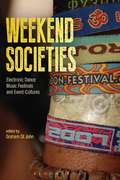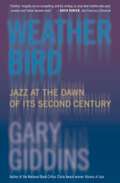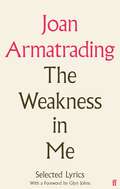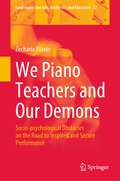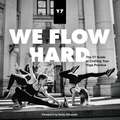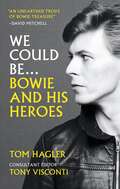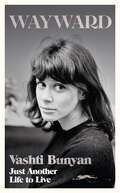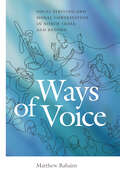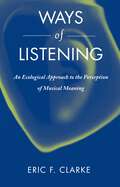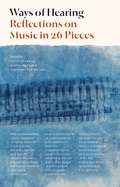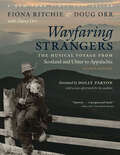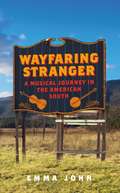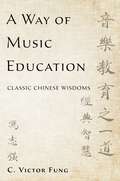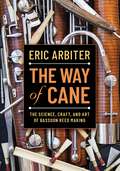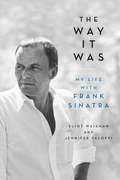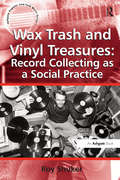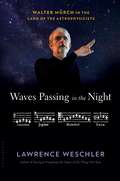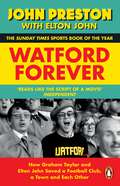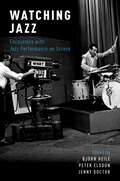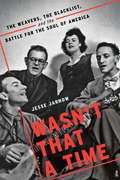- Table View
- List View
Weekend Societies: Electronic Dance Music Festivals and Event-Cultures
by Graham St JohnFrom massive raves sprouting around the London orbital at the turn of the 1990s to events operated under the control of corporate empires, EDM (Electronic Dance Music) festivals have developed into cross-genre, multi-city, transnational mega-events. From free party teknivals proliferating across Europe since the mid-1990s to colossal corporate attractions like Tomorrowland Electric Daisy Carnival and Stereosonic, and from transformational and participatory events like Burning Man and events in the UK outdoor psytrance circuit, to such digital arts and new media showcases as Barcelona's Sónar Festival and Montreal's MUTEK, dance festivals are platforms for a variety of arts, lifestyles, industries and policies.Growing ubiquitous in contemporary social life, and providing participants with independent sources of belonging, these festivals and their event-cultures are diverse in organization, intent and outcome. From ethically-charged and “boutique” events with commitments to local regions to subsidiaries of entertainment conglomerates touring multiple nations, EDM festivals are expressions of “freedoms” revolutionary and recreational. Centres of “EDM pop”, critical vectors in tourism industries, fields of racial distinction, or experiments in harm reduction, gifting culture, and co-created art, as this volume demonstrates, diversity is evident across management styles, performance legacies and modes of participation.Weekend Societies is a timely interdisciplinary volume from the emergent field of EDM festival and event-culture studies. Echoing an industry trend in world dance music culture from raves and clubs towards festivals, Weekend Societies features contributions from scholars of EDM festivals showcasing a diversity of methodological approaches, theoretical perspectives and representational styles.Organised in four sections: Dance Empires; Underground Networks; Urban Experiments; Global Flows, Weekend Societies illustrates how a complex array of regional, economic, social, cultural and political factors combine to determine the fate of EDM festivals that transpire at the intersections of the local and global.
Weather Bird: Jazz at the Dawn of Its Second Century
by Gary GiddinsGary Giddins's Weather Bird is a brilliant companion volume to his landmark in music criticism, Visions of Jazz, winner of the National Book Critics Circle Award in Criticism. More then 140 pieces, written over a 14-year period, are brought together for the first time in this superb collection of essays, reviews, and articles. Weather Bird is a celebration of jazz, with illuminating commentaryon contemporary jazz events, today's top muscicians, the best records of the year, and on leading figures from jazz's past. Readers will find extended pieces on Louis Armstrong, Erroll Garner, Benny Carter, Sonny Rollins, Dave Brubeck, Ornette Coleman, Billie Holiday, Cassandra Wilson, Tony Bennett, and many others. Giddins includes a series of articles on the annual JVC Jazz Festival, which offers a splendid overview of jazz in the 1990s. Other highlights include an astute look at avant-garde music ("Parajazz") and his challenging essay, "How Come Jazz Isn't Dead?" which advances a theory about the way art is born, exploited, celebrated, and sidelined to the museum. A radiant compendium by America's leading music critic, Weather Bird offers an unforgettable look at the modern jazz scene.
Weather Bird: Jazz at the Dawn of Its Second Century
by Gary GiddinsGary Giddins's Weather Bird is a brilliant companion volume to his landmark in music criticism, Visions of Jazz, winner of the National Book Critics Circle Award in Criticism. More then 140 pieces, written over a 14-year period, are brought together for the first time in this superb collection of essays, reviews, and articles. Weather Bird is a celebration of jazz, with illuminating commentaryon contemporary jazz events, today's top muscicians, the best records of the year, and on leading figures from jazz's past. Readers will find extended pieces on Louis Armstrong, Erroll Garner, Benny Carter, Sonny Rollins, Dave Brubeck, Ornette Coleman, Billie Holiday, Cassandra Wilson, Tony Bennett, and many others. Giddins includes a series of articles on the annual JVC Jazz Festival, which offers a splendid overview of jazz in the 1990s. Other highlights include an astute look at avant-garde music ("Parajazz") and his challenging essay, "How Come Jazz Isn't Dead?" which advances a theory about the way art is born, exploited, celebrated, and sidelined to the museum. A radiant compendium by America's leading music critic, Weather Bird offers an unforgettable look at the modern jazz scene.
The Weakness in Me: The Selected Lyrics of Joan Armatrading
by Joan ArmatradingSince the release of her debut album Whatever's For Us in 1972, Joan Armatrading has, across a fifty-year career, traversed styles and genres to create a monumental body of work. Acknowledged as the first British female singer-songwriter to gain international success, her writing is alive with intelligence and empathy and paints the human experience with insight and emotion.Selected and arranged by the author, and featuring a foreword by revered record producer Glyn Johns, The Weakness In Me presents the lyrics of Armatrading for the first time in one unique volume. It also contains an introduction by Armatrading alongside annotations to a number of songs, giving a rare, personal glimpse into the creative process of a true pioneer.
We Piano Teachers and Our Demons: Socio-psychological Obstacles on the Road to Inspired and Secure Performance (Landscapes: the Arts, Aesthetics, and Education #32)
by Zecharia PlavinThis book focuses on piano teachers and the many pains they encounter in their careers. These pains play an essential role in blocking the musical inspiration of their students. The author identifies with the sensitivities of the teachers, aiming at the inspiration permeated and safer playing of their students.The book penetrates the protective mechanisms of the teachers that, on the one hand, maintain their professional functioning, while on the other hand, block refreshing ideas. It combines exploration of secure and culturally informed inspired playing, coping with exaggerated anxiety and understanding the interaction of piano actions with pianist’s physiology.This book helps to open teachers’ perceptions of the ways to enable more secure and more inspired performances while remembering the inner feelings of the piano teachers.
We Flow Hard: The Y7 Guide to Crafting Your Yoga Practice
by Sarah Levey Mason LeveyY7 Studios co-founders Sarah and Mason Levey bring their sweat-dripping, beat-bumping practice to readers with We Flow Hard, a fitness and lifestyle book from the original hip-hop yoga studio.Y7 embodies a modern, streamlined approach to the ancient practice of vinyasa, fusing edgy aspiration with flowing, individualized yoga sequences. We Flow Hard brings the brand's signature graphic aesthetic, playful puns, and beat-bumping energy to a fitness and lifestyle guide for today's tribe of hip, provocative yogis.As practical as it is inspirational, We Flow Hard includes sections on the history and benefits of yoga, the art of crafting the perfect workout playlist, and tips on incorporating yogic practices and meditation into a contemporary lifestyle -- for people who aren't planning on becoming pious vegans. At the book's core is a series of yoga sequences, from targeted "abs and ass" moves to a Y7 spin on traditional vinyasa, and advice on customizing a yoga practice for your own skills and goals. Rigorous yet inviting, this approach to yoga is, in the words of Vogue, "For people who put on gangsta rap and handle it."
We Could Be: Bowie and his Heroes
by Tom Hagler***With consultant editor Tony Visconti. David Bowie's story has never been told quite like this.Tracing the star's encounters with fellow icons throughout his life, We Could Be offers a new history of Bowie, collecting 300 short stories that together paint a portrait of humour, humility, compassion, tragedy and more besides.He embarrasses himself in front of Lennon and Warhol. He saves the life of Nina Simone. He is hated by Bob Dylan. He teaches Michael Jackson the moonwalk. Individually astonishing, together these stories - including details never before revealed - build a new picture of Bowie, one which shows his vulnerability, his sense of humour, his inner diva.Exhaustively researched from thousands of sources by BBC reporter and Bowie obsessive Tom Hagler - with the guidance and memories of Bowie's long-time producer Tony Visconti - We Could Be is fascinating, comic, compelling, and a history of Bowie unlike any that has come before.
Wayward: Just Another Life to Live
by Vashti Bunyan'Magical and transporting . . . Wayward proves that Bunyan has lived the best possible life, on her own idiosyncratic terms'Maggie O'Farrell'A gorgeous account of outsiderness and survival: a map of how to live outside the boundaries and of striving for an authentic artistic life. A quietly defiant and moving work' Sinéad Gleeson'An epic in miniature . . . I loved - and lived - every sentence' Benjamin MyersIn 1968, Vashti Bunyan gave up everything and everybody she knew in London to take to the road with a horse, wagon, dog, guitar and her then partner. They made the long journey up to the Outer Hebrides in an odyssey of discovery and heartbreak, full of the joy of freedom and the trudge of everyday reality, sleeping in the woods, fighting freezing winters and homelessness. Along the way, Vashti wrote the songs that would lead to the recording of her 1970's album Just Another Diamond Day, the lilting lyrics and guitar conveying innocent wonder at the world around her, whilst disguising a deeper turmoil under the surface. From an unconventional childhood in post-war London, to a fledgling career in mid-sixties pop - recording a single written by Mick Jagger and Keith Richards - to the despair and failure to make any headway with her own songs, she rejected the music world altogether and left it all behind. After retreating to a musical wilderness for thirty years, the rediscovery of her recordings in 2000 brought Vashti a second chance to write, record and perform once more. One of the great hippie myths of the 1960s, Wayward, Just Another Life to Live, rewrites the narrative of a barefoot girl on the road to describe a life lived at full tilt from the first, revealing what it means to change course and her emotional struggle, learning to take back control of her own life.
Ways of Voice: Vocal Striving and Moral Contestation in North India and Beyond (Music / Culture)
by Matthew RahaimWays of Voice explores techniques of voice production in North India, from Bollywood to raga music to ghazal to devotional hymns and Sufi song. The voices in play here are not merely given, but achieved. Singers consciously train themselves to cultivate characteristic vocal gaits, sonorities, and poetic attunements; they adopt postures of the vocal apparatus; they build habits of listening, temporality, and social relations. The action in Ways of Voice revolves around several dozen North Indian popular, devotional, classical, and folk singers engaged in projects of vocal striving. Like most singers, they are strategically working on changing, refining, and making their own voices. The book thus highlights the ways in which singers not only "have" voice, but actively acquire, cultivate and contest particular vocal dispositions for particular kinds of listeners. In framing a "Hindustani vocal ecumene" that encompasses a diverse range of classical, popular, and spiritual-devotional musical styles and practices, it offers an expansive look at ways of voice that extend far beyond commonsense boundaries of genre and place. A rich archive of audio and video examples are provided on the online companion site, which can be found at https://www.weslpress.org/readers-companions/.
Ways of Listening: An Ecological Approach to the Perception of Musical Meaning
by Eric ClarkeIn recent years, many psychologists and cognitive scientists have published their views on the psychology of music. Unfortunately, this scientific literature has remained inaccessible to musicologists and musicians, and has neglected their insights on the subject. In Ways of Listening, musicologist Eric Clarke explores musical meaning, music's critical function in human lives, and the relationship between listening and musical material. Clarke outlines an "ecological approach" to understanding the perception of music. The way we hear and understand music is not simply a function of our brain structure or of the musical "codes" given to us by culture, Clarke argues. Instead, cognitive, psychoacoustical, and semiotic issues must be considered within the physical and social contexts of listening. In essence, Clarke adapts John Gibson's influential ecological theory of perception to the complex process of perceiving music. In addition to making a theoretical argument, the author offers a number of case studies to illustrate his concept. For example, he analyzes the experience of listening to Jimi Hendrix's performance of the Star Spangled Banner at Woodstock in 1969. Clarke examines how Hendrix's choice of instrument and venue, use of distortion, and the political climate in which he performed all had an impact on his audience's perception of the anthem. A complex convergence of broad cultural contexts and specific musical features - the entire "ecology" of the listening experience - is responsible for this performance's impact. Including both the best psychological research and careful musicological scholarship, Clarke's book offers the most complex and insightful perspective on musical meaning to date. It will be of interest to musicologists, musicians, psychologists, and scholars of aesthetics.
Ways of Hearing: Reflections on Music in 26 Pieces
by Scott Burnham, Marna Seltzer & Dorothea von MoltkeAn outstanding anthology in which notable musicians, artists, scientists, thinkers, poets, and more—from Gustavo Dudamel and Carrie Mae Weems to Ruth Bader Ginsburg and Paul Muldoon—explore the influence of music on their lives and workContributors include: Laurie Anderson ● Jamie Barton ● Daphne A. Brooks ● Edgar Choueiri ● Jeff Dolven ● Gustavo Dudamel ● Edward Dusinberre ● Corinna da Fonseca-Wollheim ● Frank Gehry ● James Ginsburg ● Ruth Bader Ginsburg ● Jane Hirshfield ● Pico Iyer ● Alexander Kluge ● Nathaniel Mackey ● Maureen N. McLane ● Alicia Hall Moran ● Jason Moran ● Paul Muldoon ● Elaine Pagels ● Robert Pinsky ● Richard Powers ● Brian Seibert ● Arnold Steinhardt ● Susan Stewart ● Abigail Washburn ● Carrie Mae Weems ● Susan Wheeler ● C. K. Williams ● Wu FeiWhat happens when extraordinary creative spirits—musicians, poets, critics, and scholars, as well as an architect, a visual artist, a filmmaker, a scientist, and a legendary Supreme Court justice—are asked to reflect on their favorite music? The result is Ways of Hearing, a diverse collection that explores the ways music shapes us and our shared culture. These acts of musical witness bear fruit through personal essays, conversations and interviews, improvisatory meditations, poetry, and visual art. They sound the depths of a remarkable range of musical genres, including opera, jazz, bluegrass, and concert music both classical and contemporary.This expansive volume spans styles and subjects, including Pico Iyer’s meditations on Handel, Arnold Steinhardt’s thoughts on Beethoven’s Grosse Fuge, and Laurie Anderson and Edgar Choueiri’s manifesto for spatial music. Richard Powers discusses the one thing about music he’s never told anyone, Daphne Brooks draws sonic connections between Toni Morrison and Cécile McLorin Salvant, and Ruth Bader Ginsburg reveals what she thinks is the sexiest duet in opera. Poems interspersed throughout further expand how we can imagine and respond to music. Ways of Hearing is a book for our times that celebrates the infinite ways music enhances our lives.
Wayfaring Strangers: The Musical Voyage from Scotland and Ulster to Appalachia
by Fiona Ritchie Doug OrrFrom the seventeenth through the nineteenth centuries, a steady stream of Scots migrated to Ulster and eventually onward across the Atlantic to resettle in the United States. Many of these Scots-Irish immigrants made their way into the mountains of the southern Appalachian region. They brought with them a wealth of traditional ballads and tunes from the British Isles and Ireland, a carrying stream that merged with sounds and songs of English, German, Welsh, African American, French, and Cherokee origin. Their enduring legacy of music flows today from Appalachia back to Ireland and Scotland and around the globe. Ritchie and Orr guide readers on a musical voyage across oceans, linking people and songs through centuries of adaptation and change.Enriched by the insights of key contributors to the living tradition on both sides of the Atlantic, accompanying this abundantly illustrated volume is an online Spotify playlist featuring over 20 songs by musicians profiled in the book, including Dolly Parton, Dougie MacLean, Cara Dillon, John Doyle, Pete Seeger, Sheila Kay Adams, Jean Ritchie, Doc Watson, David Holt, Anais Mitchell, Al Petteway, and more.
Wayfaring Stranger: A Musical Journey in the American South
by Emma JohnCan you feel nostalgic for a life you've never known?Suffused with her much-loved warmth and wit, Emma John's memoir follows her moving and memorable journey to master one of the hardest musical styles on earth - and to find her place in an alien world.Emma had fallen out of love with her violin when a chance trip to the American South introduced her to bluegrass music. Classically trained, highly strung and wedded to London life, Emma was about as country as a gin martini. So why did it feel like a homecoming?Answering that question takes Emma deep into the Appalachian mountains, where she uncovers a hidden culture that confounds every expectation - and learns some emotional truths of her own.
WAY OF MUSIC EDUCATION C: Classic Chinese Wisdoms
by C. Victor FungMoving back through Dewey, Heidegger, Nietzsche, and Rousseau, the lineage of Western music education finds its origins in Plato and Pythagoras. Yet theories not rooted in the ancient Greek tradition are all but absent. A Way of Music Education provides a much-needed intervention, integrating ancient Chinese thought into the canon of music education in a structured, systematized, and philosophical way. The book's three central sources - the Yijing (The Book of Changes), Confucianism, and Daoism - inform author C. Victor Fung's argument: that the human being exists as an entity at the center of an organismic world in which all things and events, including music and music education, are connected. Fung ultimately proposes a new educational philosophy based on three key ideas in Chinese thought: change, balance, and liberation. A unique work, A Way of Music Education offers a universal approach engrained in a specific and ancient cultural tradition.
A Way of Music Education: Classic Chinese Wisdoms
by C. Victor FungMoving back through Dewey, Heidegger, Nietzsche, and Rousseau, the lineage of Western music education finds its origins in Plato and Pythagoras. Yet theories not rooted in the ancient Greek tradition are all but absent. A Way of Music Education provides a much-needed intervention, integrating ancient Chinese thought into the canon of music education in a structured, systematized, and philosophical way. The book's three central sources - the Yijing (The Book of Changes), Confucianism, and Daoism - inform author C. Victor Fung's argument: that the human being exists as an entity at the center of an organismic world in which all things and events, including music and music education, are connected. Fung ultimately proposes a new educational philosophy based on three key ideas in Chinese thought: change, balance, and liberation. A unique work, A Way of Music Education offers a universal approach engrained in a specific and ancient cultural tradition.
WAY OF CANE C: The Science, Craft, and Art of Bassoon Reed-making
by Eric ArbiterAs the sound-producing mechanism for the bassoon, the reed is a vital component in the sound of the entire instrument. While pre-manufactured reeds are widely available for purchase at music stores, this one-size-fits-all option hardly does justice to the unique needs of the musician and the piece. Many bassoonists, including seasoned professional bassoonist Eric Arbiter, instead choose to craft their own reeds. A nuanced and difficult craft to master, reed-making involves specialized machinery and necessitates special attention to the thickness, and even topography, of the reed itself. When done correctly, however, this process results in a reed that not only produces a more beautiful sound, but also holds up to even the most demanding musical performances. In The Way of Cane, Arbiter demystifies this process for bassoonists of all levels of experience. Drawing from his decades-long experience as both musician and reed-maker, Arbiter provides a comprehensive yet accessible overview of the craft, from the differing sound qualities produced by changing the dimensions of the reed's blades to the changes in the reed's behaviors as it passes through cycles of wetting and drying during production. Small changes in each of these variables, Arbiter explains, contribute to the ultimate goal of producing a bassoonist's ideal sound. With step-by-step instructions, detailed photos that further illuminate the reed-making process, and a companion website featuring the author's own recordings. The Way of Cane emphasizes the importance of the reed to the bassoon's sound, as well as the harmony between reed and musician.
The Way of Cane: The Science, Craft, and Art of Bassoon Reed-making
by Eric ArbiterAs the sound-producing mechanism for the bassoon, the reed is a vital component in the sound of the entire instrument. While pre-manufactured reeds are widely available for purchase at music stores, this one-size-fits-all option hardly does justice to the unique needs of the musician and the piece. Many bassoonists, including seasoned professional bassoonist Eric Arbiter, instead choose to craft their own reeds. A nuanced and difficult craft to master, reed-making involves specialized machinery and necessitates special attention to the thickness, and even topography, of the reed itself. When done correctly, however, this process results in a reed that not only produces a more beautiful sound, but also holds up to even the most demanding musical performances. In The Way of Cane, Arbiter demystifies this process for bassoonists of all levels of experience. Drawing from his decades-long experience as both musician and reed-maker, Arbiter provides a comprehensive yet accessible overview of the craft, from the differing sound qualities produced by changing the dimensions of the reed's blades to the changes in the reed's behaviors as it passes through cycles of wetting and drying during production. Small changes in each of these variables, Arbiter explains, contribute to the ultimate goal of producing a bassoonist's ideal sound. With step-by-step instructions, detailed photos that further illuminate the reed-making process, and a companion website featuring the author's own recordings. The Way of Cane emphasizes the importance of the reed to the bassoon's sound, as well as the harmony between reed and musician.
The Way It Was: My Life with Frank Sinatra
by Eliot Weisman Jennifer ValoppiA candid and eye-opening inside look at the final decades of Sinatra's life told by his longtime manager and friend, Eliot Weisman.By the time Weisman met Sinatra in 1976, he was already the Voice, a man who held sway over popular music and pop culture for forty years, who had risen to the greatest heights of fame and plumbed the depths of failure, all the while surviving with the trademark swagger that women pined for and men wanted to emulate. Passionate and generous on his best days, sullen and unpredictable on his worst, Sinatra invited Weisman into his inner circle, an honor that the budding celebrity manager never took for granted. Even when he was caught up in a legal net designed to snare Sinatra, Weisman went to prison rather than being coerced into telling prosecutors what they wanted to hear. With Weisman's help, Sinatra orchestrated in his final decades some of the most memorable moments of his career. There was the Duets album, which was Sinatra's top seller, the massive tours, such as Together Again, which featured a short-lived reunion of the Rat Pack--until Dean Martin, having little interest in reliving the glory days, couldn't handle it anymore--and the Ultimate Event Tour, which brought Liza Minelli and Sammy Davis Jr. on board and refreshed the much-needed lining of both their pocketbooks. Weisman also worked with many other acts, including Steve Lawrence and Eydie Gorme, and an ungrateful Don Rickles, whom Weisman helped get out from under the mob's thumb. Over their years together, Weisman became a confidant to the man who trusted few, and he came to know Sinatra's world intimately: his wife, Barbara, who socialized with princesses and presidents and tried to close Sinatra off from his rough and tough friends such as Jilly Rizzo; Nancy Jr., who was closest to her dad; Tina, who aggressively battled for her and her siblings' rights to the Sinatra legacy and was most like her father; and Frank Jr., the child with the most fraught relationship with the legendary entertainer. Ultimately Weisman, who had become the executor of Sinatra's estate, was left alone to navigate the infighting and hatred between those born to the name and the wife who acquired it, when a mystery woman showed up and threatened to throw the family's future into jeopardy. Laden with surprising, moving, and revealing stories, The Way It Was also shows a side of Sinatra few knew. As a lion in winter, he was struggling with the challenges that come with old age, as well as memory loss, depression, and antidepressents. Weisman was by his side through it all, witness to a man who had towering confidence, staggering fearlessness, and a rarely seen vulnerability that became more apparent as his final days approached.
Wax Trash and Vinyl Treasures: Record Collecting as a Social Practice
by Roy ShukerThe term 'record collecting' is shorthand for a variety of related practices. Foremost is the collection of sound recordings in various formats - although often with a marked preference for vinyl - by individuals, and it is this dimension of record collecting that is the focus of this book. Record collecting, and the public stereotypes associated with it, is frequently linked primarily with rock and pop music. Roy Shuker focuses on these broad styles, but also includes other genres and their collectors, notably jazz, blues, exotica and 'ethnic' music. Accordingly, the study examines the history of record collecting; profiles collectors and the collecting process; considers categories - especially music genres - and types of record collecting and outlines and discusses the infrastructure within which collecting operates. Shuker situates this discussion within the broader literature on collecting, along with issues of cultural consumption, social identity and 'the construction of self' in contemporary society. Record collecting is both fascinating in its own right, and provides insights into broader issues of nostalgia, consumption and material culture.
Wax Trash and Vinyl Treasures: Record Collecting As A Social Practice (Ashgate Popular And Folk Music Ser.)
by Roy ShukerThe term 'record collecting' is shorthand for a variety of related practices. Foremost is the collection of sound recordings in various formats - although often with a marked preference for vinyl - by individuals, and it is this dimension of record collecting that is the focus of this book. Record collecting, and the public stereotypes associated with it, is frequently linked primarily with rock and pop music. Roy Shuker focuses on these broad styles, but also includes other genres and their collectors, notably jazz, blues, exotica and 'ethnic' music. Accordingly, the study examines the history of record collecting; profiles collectors and the collecting process; considers categories - especially music genres - and types of record collecting and outlines and discusses the infrastructure within which collecting operates. Shuker situates this discussion within the broader literature on collecting, along with issues of cultural consumption, social identity and 'the construction of self' in contemporary society. Record collecting is both fascinating in its own right, and provides insights into broader issues of nostalgia, consumption and material culture.
Waves Passing in the Night: Walter Murch in the Land of the Astrophysicists
by Lawrence WeschlerFrom Pulitzer Prize nominee Lawrence Weschler, a fascinating profile of Walter Murch, a film legend and amateur astrophysicist whose investigations could reshape our understanding of the universe.For film aficionados, Walter Murch is legendary--a three-time Academy Award winner, arguably the most admired sound and film editor in the world for his work on Apocalypse Now, The Godfather trilogy, The English Patient, and many others. Outside of the studio, his mind is wide-ranging; his passion, pursued for several decades, has been astrophysics, in particular the rehabilitation of Titius-Bode, a long-discredited 18th century theory regarding the patterns by which planets and moons array themselves in gravitational systems across the universe. Though as a consummate outsider he's had a hard time attracting any sort of comprehensive hearing from professional astrophysicists, Murch has made advances that even some of them find intriguing, including a connection between Titius Bode and earlier notions--going back past Kepler and Pythagorus--of musical harmony in the heavens. Unfazed by rejection, ever probing, Murch perseveres in the highest traditions of outsider science.Lawrence Weschler brings Murch's quest alive in all its seemingly quixotic, yet still plausible, splendor, probing the basis for how we know what we know, and who gets to say. "The wholesale rejection of alternative theories has repeatedly held back the progress of vital science," Weschler observes, citing early twentieth-century German amateur Alfred Wegener, whose speculations about continental drift were ridiculed at first, only to be accepted as fact decades later. Theoretical physicist Lee Smolin says "It is controversy that brings science alive"--and Murch's quest does that in spades. His fascination with the way the planets and their moons are arranged opens up the field of celestial mechanics for general readers, sparking an awareness of the vast and (to us) invisible forces constantly at play in the universe.
Watford Forever: How Graham Taylor and Elton John Saved a Football Club, a Town and Each Other
by John Preston Elton JohnThe Sunday Times Sports Book of the YearA Times Book of the YearA Financial Times Book of the YearA Guardian Book of the YearA New Statesman Book of the Year'The heartwarming story of the collaboration and friendship between English football’s oddest couple, Elton John and Graham Taylor' The Times' A wonderful, feel-good account of an ultimately English provincial story' Simon Kuper_____________________ An unforgettable British underdog story from one of our greatest narrative nonfiction writers, John Preston, and the international musical icon and bestselling author, Sir Elton John.Britain in the 1970s was beset by unrest and unemployment, as inflation soared, fuel was scarce, and hooliganism was on the rise. And for Watford FC, the outlook was even gloomier. Rundown and rat-infested, Watford were an ailing side with holes in their kit and barely enough fans to fill a stand. Of the 92 clubs in the Football League, spread across four divisions, Watford were in 92nd place.Meanwhile, Elton John was the most successful rockstar in the world. With six-inch platforms, spangled jumpsuits, and peroxide hair, he was glamorous, gay, and seemingly a world away from the semi-detached house in Pinner where he had supported Watford FC as a child. Many assumed he would move to America. Instead, he bought the football club.Watford Forever is the remarkable story of Elton John's ownership of Watford FC and its transformational journey to the top of the First Division under iconic manager Graham Taylor. Perhaps most remarkably, four of the same players who had been written off as has-beens went with them all the way from the bottom to the top. Inspiring and infectiously funny, this is a tribute to football's unlikeliest friendship as Elton John and Taylor, a straight-talking former fullback with a love of Vera Lynn, beat the odds and their personal demons to save a club and a community.Immersed in the grime and glamour of '70s Britain, Watford Forever is one of sport's great underdog stories and a love letter to the beautiful game.
WATCHING JAZZ C: Encounters with Jazz Performance on Screen
by Björn Heile, Peter Elsdon, and Jenny DoctorWatching Jazz: Encounters with Jazz Performance on Screen is the first systematic study of jazz on screen media. Where earlier studies have focused almost entirely on the role and portrayal of jazz in Hollywood film, the present book engages with a plethora of technologies and media from early film and soundies through television to recent developments in digital technologies and online media. Likewise, the authors discuss jazz in the widest sense, ranging from Duke Ellington and Jimmy Dorsey through the likes of Dizzy Gillespie, Art Blakey, Oscar Peterson, Miles Davis, John Coltrane and Charles Mingus to Pat Metheny. Much of this rich and fascinating material has never been studied in depth before, and what emerges most clearly are the manifold connections between the music and the media on which it was and is being recorded. Its long association with film and television has left its trace in jazz, just as online and social media are subtly shaping it now. Vice versa, visual media have always benefited from focusing on music and this significantly affected their development. The book follows these interrelations, showing how jazz was presented and represented on screen and what this tells us about the music, the people who made it and their audiences. The result is a new approach to jazz and the media, which will be required reading for students of both fields.
Watching Jazz: Encounters with Jazz Performance on Screen
by Bjö Heile Peter Elsdon Jenny DoctorWatching Jazz: Encounters with Jazz Performance on Screen is the first systematic study of jazz on screen media. Where earlier studies have focused almost entirely on the role and portrayal of jazz in Hollywood film, the present book engages with a plethora of technologies and media from early film and soundies through television to recent developments in digital technologies and online media. Likewise, the authors discuss jazz in the widest sense, ranging from Duke Ellington and Jimmy Dorsey through the likes of Dizzy Gillespie, Art Blakey, Oscar Peterson, Miles Davis, John Coltrane and Charles Mingus to Pat Metheny. Much of this rich and fascinating material has never been studied in depth before, and what emerges most clearly are the manifold connections between the music and the media on which it was and is being recorded. Its long association with film and television has left its trace in jazz, just as online and social media are subtly shaping it now. Vice versa, visual media have always benefited from focusing on music and this significantly affected their development. The book follows these interrelations, showing how jazz was presented and represented on screen and what this tells us about the music, the people who made it and their audiences. The result is a new approach to jazz and the media, which will be required reading for students of both fields.
Wasn't That a Time: The Weavers, the Blacklist, and the Battle for the Soul of America
by Jesse JarnowThe dramatic untold story of the Weavers, the hit-making folk-pop quartet destroyed with the aid of the United States government -- and who changed the world, anyway Following a series of top-ten hits that became instant American standards, the Weavers dissolved at the height of their fame. Wasn't That a Time: The Weavers, the Blacklist, and the Battle for the Soul of America details the remarkable rise of Pete Seeger's unlikely band of folk heroes, from basement hootenannies to the top of the charts, and the harassment campaign that brought them down. Exploring how a pop group's harmonies might be heard as a threat worthy of decades of investigation by the FBI, Wasn't That a Time turns the black-and-white 1950s into vivid color, using the Weavers to illuminate a dark and complex period of American history. With origins in the radical folk collective the Almanac Singers and the ambitious People's Songs, the singing activists in the Weavers set out to change the world with songs as their weapons, pioneering the use of music as a transformative political organizing tool. Using previously unseen journals and letters, unreleased recordings, once-secret government documents, and other archival research, Jesse Jarnow uncovers the immense hopes, incredible pressures, and daily struggles of the four distinct and often unharmonious personalities at the heart of the Weavers. In an era defined by a sharp political divide that feels all too familiar, the Weavers became heroes. With a class -- and race -- conscious global vision that now makes them seem like time travelers from the twenty-first century, the Weavers became a direct influence on a generation of musicians and listeners, teaching the power of eclectic songs and joyous, participatory harmonies.
